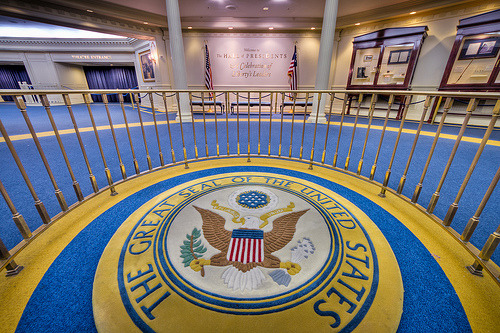Religion in Animatronic History
Elesha Coffman
Surprised by a mid-day, 20-degree temperature drop at Disney
World last month, my daughter and I took shelter in the Hall of Presidents, an
exhibit we probably would have skipped otherwise. The show consisted of a film,
narrated by Morgan Freeman, and animatronic figures of all 44 presidents, of
whom only Abraham Lincoln and Barack Obama had memorable speaking parts. The
overall presentation was short on overt religious references—I caught a few
mentions of God by Lincoln, a photo (not commented upon) of LBJ with Billy
Graham, and a chorus of “The Battle Hymn of the Republic” in the finale—but it instead
provided an interesting perspective on the president as, in the recently
controversial words of Atlanta pastor Andy Stanley, the nation’s “pastor
in chief.”
The subsequent Lincoln section broke the narrative flow, as
the movie screen lifted and the audio-animatronic president emerged to say his
piece. A version of this section, “Great Moments with Mr. Lincoln,” debuted at
the World’s Fair in 1964, and it still stood out from the material surrounding it,
in part because of its greater length and depth. Lincoln was not reduced to a
single characteristic, but he was linked to the “march of democracy” theme
through Freeman’s introduction, which emphasized that Lincoln was the first
president who truly believed that all men were created equal.
Skipping several fairly unmemorable gentlemen, the film
picked up again with Teddy Roosevelt. Another man of the people—Freeman told us
that Roosevelt refused to call his residence the Executive Mansion, dubbing it simply
the “white house”—he was lauded primarily for his ebullient personality, which
was on display in numerous grinning pictures. The next featured figure,
Franklin Delano Roosevelt, got largely the same treatment. Humbled by polio,
Disney’s FDR mainly contributed to history via the fireside chats that lifted
American spirits during the Great Depression. Then the youthful John F. Kennedy
imparted hopeful energy that propelled demonstrations for civil rights and
women’s equality.
Following “commoner in chief” and “cheerleader in chief,”
the Hall of Presidents gave us a vision of our political leader as “counselor
in chief.” We heard, and saw in photos, Ronald Reagan consoling the nation
after the Challenger disaster, Bill Clinton after Oklahoma City, and George W.
Bush after 9/11. Collective grief counseling was the most obviously pastoral of
the presidential roles and traits on display, and it was the one Andy Stanley
had in mind when he referred to post-Newtown Obama. But the high priest of
American civil religion, it seems, must be able to perform all three of the
duties emphasized in the Hall of Presidents: evoke our common peoplehood, fire
up our spirits, and shepherd us in our collective grief. The pastor in chief
doesn’t just do funerals. Those are merely the events at which we glimpse some
of the many overlapping expectations of presidential and pastoral leadership.


Comments
I'm currently reading through Christopher Chapp's Religious Rhetoric and American Politics (Cornell, 2012) and it's amazing how your observations dovetailed with his central arguments. I'm finding it a good, empirical updating of the subject of civil religion, especially as it challenges the idea of a normative culture war. At the same time, Chapp realizes that what he calls "civil religious identity" is largely a Puritan/Protestant construct and, thus, potentially as exclusive as inclusive. Did you find the Hall of Presidents likewise reliant on Protestant preconceptions of personal autonomy or other?